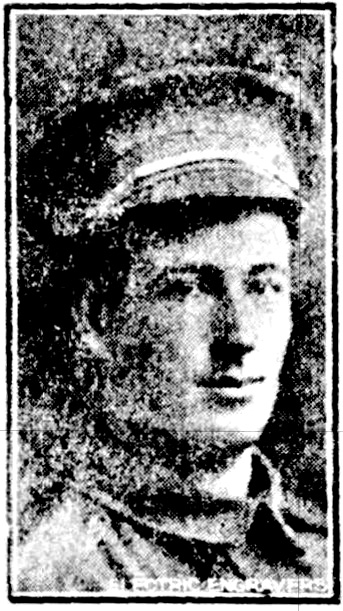Thomas Bird
From Our Contribution
 Western Mail 18 Feb 1917 | |
| Personal Information | |
|---|---|
| Date of Birth | 26 Apr 1894 |
| Place of Birth | Wilmington, South Australia |
| Death | 27 Feb 1966 |
| Place of Death | West Leederville, Western Australia |
| Age at Enlistment | 21 years, 7 months |
| Description |
5' 11" (1.80m) tall ; 174 lbs 78.925 kg ; fresh complexion ; brown eyes ; brown hair ; Top forefinger missing on right hand |
| Occupation | Labourer |
| Religion | Methodist |
| Address | Mundijong, Western Australia |
| Next of Kin | Father , Mr Joseph Bird |
| Military Information | |
| Reg Number | 3789 |
| Date of Enlistment | 22 Nov 1915 |
| Rank | Private |
| Unit/Formation | 28th Battalion, 9th Reinforcement transferred to 51st Battalion / 13th Brigade, 4th Division |
| Date of Embarkation | 22 Feb 1916 ‒ 10 Apr 1916 |
| Ship Embarked On | HMAT A28 Miltiades Avonmouth to Fremantle |
| Date of Return | 22 Feb 1917 ‒ 10 Apr 1917 |
| Ship Returned On | HMAT A63 Karoola |
| Fate |
Wounded in Action 15 Aug 1916 Mouquet Farm, Pozierés Returned to Australia |
| Monument |
Armadale War Memorial (Beenup panel) Mundijong School Roll of Honour Mundijong Honour Roll Armadale and Districts Roll of Honour ANZAC Memorial Park (Byford) |
| Medals |
British War Medal Victory Medal Queen Elizabeth II Coronation Medal |
Pre War
Prior to enlistment he was working as a fettler at the 9 mile camp, Wellington.
War Service
Entering camp, Thomas was assigned to the 36th Depot Company for the first five weeks at Blackboy Hill camp. On 28 Dec 1915 Thomas was allocated to the 9th reinforcement draft for the 28th Battalion, and he travelled to Egypt with them.
On arrival he was posted to the 7th Training Battalion, and three weeks later Thomas was reassigned to the newly formed 51st Battalion at Serapeum. He then trained with them before travelling with them aboard the HMT Ivernia from Alexandria to Marseilles in France. Boarding on 4 Jun 1916, they disembarked on 12 Jun 1916.
On the 14th August 1916, Thomas's unit was part of a major attack on the Mouquet Farm. They were tasked with capturing Fabeck Graben, a major trench to the south east of the farm proper. This they succeeded in doing on the night of the 14th, but under sustained German artillery bombardment and after repeated German attempts to recapture the trench, on the 15th the Australians were forced to withdraw across no man's land under heavy fire. It is likely that this is when Thomas received his wounds either from machine gun fire or from a shell. He suffered a severe GSW to his left knee.
Treated at the 1st Canadian General Hospital in Étaples, he was evacuated on 20 Aug 1916 to England from Calais on HMHS Newhaven and admitted to the Bradford War Hospital on 21 Aug 1916. Following extensive treatment he was transferred to the 1st Australian Auxiliary Hospital on 24 Jan 1917 before being invalided home aboard HMAT A63 Karoola from Avonmouth on 22 Feb 1917.
Back in Australia he spent another six months in the Army before being well enough to be discharged on medical grounds by the 5th Military District on 9 Oct 1917.
"wounded at the fight at Mouquet Farm, 15th August 1916. Convalescent in Bradford Hospital, Yorkshire."[1]
224th Casualty List WOUNDED.... T. Bird (Mundijong).......[along with his brother C. Bird (Mundijong) who is only slightly wounded and remains on duty.][2]
Post War
"Following upon Mr. O'Grady's resignation, applications were called for the position, and seven answers were to hand. The successful applicant, Mr T. Bird was appointed to the position, at the General Meeting on Thursday night last, the 10th of January, 1924. Before the war, Mr. Bird was a sleeper-cutter and champion axeman, and during the war he saw service with the 51st Battalion in Egypt and France, where he was badly wounded at Pozieres. On his return he tried to adapt himself to clerical life, and was one of the successful candidates who passed the Commonwealth Public Service Examination held in Perth on the 26th August, 1920, and numbers among those who still await the fulfilment of the Commonwealth Government's promise to establish these men in employment. Mr Bird has also been an Executive Member for the last three years."[3]
While Thomas did not hold the position for long, he did remain living in West Leederville with his wife Lillian for the rest of his life.
Thomas's name appears on a list of RSL members and others granted a Coronation Medal by the Queen.[4]
Married Lillian Mary Ingram in 1922 (b.1894) and she died 21 Jul 1987 aged 92 in Manning. They had 2 children, one of whom was Stanley Vernon (1926 - 2002) who served in the Australian Navy with service No. F5208.
Notes
The Queen Elizabeth II Coronation Medal was established in 1953 and was awarded to Commonwealth citizens who had participated at her coronation or had given exceptional community service. A total of 11,561 were awarded to Australians.
References
- ↑ "The Drill of the Foot-Hills" (PDF) (1917). Western Australia. Mar 1917. p. 13. Retrieved 16 May 2017 – via State Library of Western Australia.
- ↑ "WESTERN AUSTRALIA.". The West Australian. XXXII, (4,524). Western Australia. 30 September 1916. p. 7. Retrieved 25 May 2017 – via National Library of Australia.
- ↑ The Listening Post January 1924
- ↑ "Queen Gives Coronation Medals To Many In West Australia". The West Australian. 69, (20,863). Western Australia. 3 June 1953. p. 14. Retrieved 25 May 2017 – via National Library of Australia.